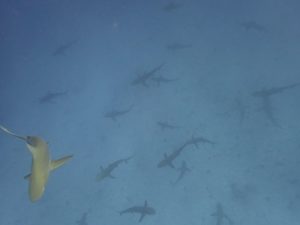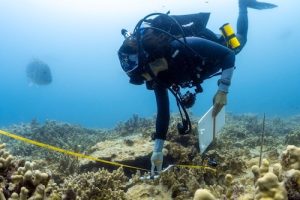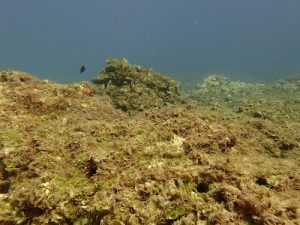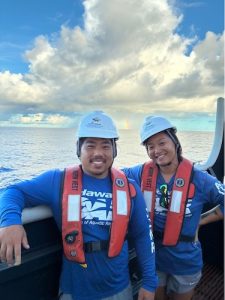10/24/25 – DAR in Papahānaumokuākea: 2025 RAMP Cruise Recap
Fearless Fish

A curious ulua getting up close and personal. Photo credit: A. Tsang
If you hear divers talking about being more scared of ulua (Giant trevally) than sharks, they are most likely talking about diving in Papahānaumokuākea! This is one of the few places in the Hawaiian archipelago where it is guaranteed that on every dive you will encounter either an ulua or a shark, usually multiple! And if you’re unlucky, there’s a higher chance of you getting bitten by an ulua than a shark. Yes, that has happened before! But that is what a healthy, marine ecosystem looks like – a truly thriving reef should be dominated by apex predators such as sharks, jacks, and snappers. Due to the remoteness of Papahānaumokuākea, wildlife are not used to seeing humans and therefore are very curious. Sometimes too curious. It’s not uncommon to get close fly-bys from ulua and sharks!
RAMPing up Research
This past summer, the Division of Aquatic Resources’ (DAR) Aquatic Biologist Anita Tsang and senior technician Richard Chen from the Aquatic Invasive Species program had the privilege to join the 2025 National Oceanic & Atmospheric Administration’s (NOAA), Office of National Marine Sanctuaries (ONMS) Reef Assessment and Monitoring Program (RAMP) research cruise up to Papahānaumokuākea. The 24-day trip included stops at Lalo (French Frigate Shoals), Kamole (Laysan), Kapou (Lisianski), Hōlanikū (Kure), Manawai (Pearl & Hermes), and Kuaihelani (Midway) where fish, coral health, limu, and urchin surveys were conducted.

Descending down into a reef full of sharks at Lalo. Photo credit: A. Tsang
Research on the Reef
Anita was diving as part of the coral health survey team, along with Kailey Pascoe (PhD candidate at University of Hawai‘i at Hilo and researcher from MEGA Lab) and Ethan Nash (NOAA). Coral health surveys included doing fish species and size counts, documenting all coral species and health conditions along the study transect, and conducting Structure from Motion (SfM) surveys that allow the creation of 3D photomosaic models of the reef. These coral health surveys contribute to a long-term dataset that is about 20 years long and provide resource managers important information around coral conditions in Papahānaumokuākea such as presence (or absence) of diseases, bleaching, predation, and other signs of stress.

Anita conducting coral health surveys at Kapou. Photo credit: Nick Zachar- NOAA
Interestingly, even though Papahānaumokuākea is generally considered a ʻpristine’ area with healthy reefs, it was saddening to see that several reefs out there were still recovering from past bleaching and hurricane events. Reefs that had suffered high coral mortality from the 2014/2015 bleaching event and the hurricane that hit Papahānaumokuākea in 2018 still had low coral cover, but it was promising to see many new recruits slowly coming back. Nevertheless, there were still healthy reefs with high coral cover, and it was amazing to see a lot of coral diversity that is not commonly seen in the Main Hawaiian Islands!
Looking Closely at Limu

A reef at Manawai that is covered by algae C. tumulosa and Microdictyon. Photo credit: A. Tsang
Richard participated in the limu (algae) and urchin surveys which were new additions to the RAMP cruise this year. Historically limu has been understudied on these RAMP cruises, relative to corals and fishes. However, limu and urchins play an important ecological role in coral reefs. Limu is a major food source for many marine life such as fishes and urchins, and the grazing or feeding on limu by these animals is critical to maintain balance on the reef as algal blooms can overgrow and smother corals. Monitoring limu and urchins allow managers and researchers to get a better picture around the general health of a coral reef.
A nuisance alga, first noted in 2016, inspired this year’s limu surveys. In 2016, researchers discovered an unusual red limu growing in thick mats at Manawai. Within three years, subsequent cruises were shocked to find that this unknown alga had begun to spread rapidly over multiple reefs, killing a lot of corals and other native limu. In 2020 the limu was assigned the name Chondria tumulosa, and by 2023 it had spread to Kuaihelani and Hōlanikū. During the RAMP cruise this year, anecdotal observations revealed that a lot of the C. tumulosa have appeared to die back, but there were still several reefs that had high cover of the red alga and many reefs that were previously covered by C. tumulosa were dead. The limu and urchin surveys will allow us to continue to monitor C. tumulosa populations and other unusual changes in benthic composition. DAR is also currently working with University of Hawaiʻi researchers and NOAA to better understand the life history characteristics of this limu and what might cause these blooms.
Seven Sentries
DAR is one of the seven co-managing agencies that work together as a collective to manage and preserve the biological, cultural, and historical significance of the Papahānaumokuākea Marine National Monument. The State of Hawaiʻi is also a co-manager of Papahānaumokuākea National Marine Sanctuary with NOAA ONMS. DAR hopes to continue to partner with NOAA ONMS on the RAMP research cruises to better manage and protect the unique resources of Papahānaumokuākea and is looking forward to ongoing collaboration and expansion of co-management partnerships to support Papahānaumokuākea.
Authors: Anita Tsang and Richard Chen

Senior technician Richard Chen and aquatic biologist Anita Tsang on the research ship
